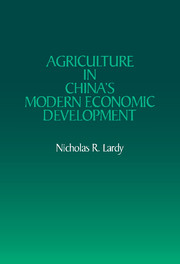Book contents
- Frontmatter
- Contents
- List of tables, figures, and maps
- Preface
- Map 1 The provinces of the People's Republic of China
- 1 The role of agriculture
- 2 Planning and allocative efficiency
- 3 Prices and intersectoral resource transfers
- 4 Living standards and the distribution of income
- 5 Prospects for reform
- Appendixes
- Notes
- References
- Index
4 - Living standards and the distribution of income
Published online by Cambridge University Press: 16 September 2009
- Frontmatter
- Contents
- List of tables, figures, and maps
- Preface
- Map 1 The provinces of the People's Republic of China
- 1 The role of agriculture
- 2 Planning and allocative efficiency
- 3 Prices and intersectoral resource transfers
- 4 Living standards and the distribution of income
- 5 Prospects for reform
- Appendixes
- Notes
- References
- Index
Summary
China's economy has undergone significant economic growth and structural change since the Communist Party rose to power in 1949. Yet, as shown in the previous chapter, the sectoral allocation of resources has been imbalanced, emphasizing industry, particularly producer goods, rather than agriculture. The puzzling intertemporal growth path referred to in the Preface seems to be partly a consequence of the skewed allocation of investment resources, lack of adequate price incentives for agriculturalists, and periods of increasing allocative inefficiency stemming from quantity planning and efforts to meet the goal of local foodgrain self-sufficiency. China's land-short resource endowment is a constraint on rapid growth, but one that has been compounded rather than alleviated by policy.
China's imbalanced growth strategy is evident not only in the allocation of investment resources and its relative price structure but also, as will be shown in this chapter, in the stagnation of average food consumption between the mid-1950s and the middle to late 1970s. After 1949 agriculture recovered from wartime devastation, and by 1957–58 average per capita food consumption recovered to the prewar level. In the subsequent two decades, however, the quantitative and qualitative standard of the average diet was significantly below that of 1957–58. Average food consumption surpassed the level of the mid-1950s only at the end of the 1970s, when more favorable price, marketing, and production incentives increased levels of agricultural production, particularly of nongrain crops.
- Type
- Chapter
- Information
- Agriculture in China's Modern Economic Development , pp. 146 - 189Publisher: Cambridge University PressPrint publication year: 1983



